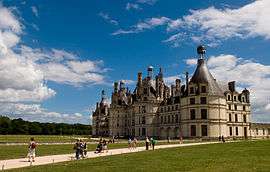Chambord, Loir-et-Cher
| Chambord | ||
|---|---|---|
|
Château de Chambord | ||
| ||
 Chambord | ||
|
Location within Centre-Val de Loire region  Chambord | ||
| Coordinates: 47°36′50″N 1°31′12″E / 47.6139°N 1.52°ECoordinates: 47°36′50″N 1°31′12″E / 47.6139°N 1.52°E | ||
| Country | France | |
| Region | Centre-Val de Loire | |
| Department | Loir-et-Cher | |
| Arrondissement | Blois | |
| Canton | Bracieux | |
| Intercommunality | Pays de Chambord | |
| Government | ||
| • Mayor (2014–2020) | André Joly | |
| Area1 | 54.38 km2 (21.00 sq mi) | |
| Population (2013)2 | 115 | |
| • Density | 2.1/km2 (5.5/sq mi) | |
| Time zone | CET (UTC+1) | |
| • Summer (DST) | CEST (UTC+2) | |
| INSEE/Postal code | 41034 / 41250 | |
| Elevation |
72–129 m (236–423 ft) (avg. 81 m or 266 ft) | |
|
1 French Land Register data, which excludes lakes, ponds, glaciers > 1 km² (0.386 sq mi or 247 acres) and river estuaries. 2 Population without double counting: residents of multiple communes (e.g., students and military personnel) only counted once. | ||
Chambord is a commune in the Loir-et-Cher department in central France.[1]
Population
| Historical population | ||
|---|---|---|
| Year | Pop. | ±% |
| 1793 | 474 | — |
| 1806 | 417 | −12.0% |
| 1821 | 396 | −5.0% |
| 1831 | 400 | +1.0% |
| 1841 | 327 | −18.2% |
| 1851 | 354 | +8.3% |
| 1861 | 308 | −13.0% |
| 1872 | 308 | +0.0% |
| 1881 | 264 | −14.3% |
| 1891 | 436 | +65.2% |
| 1901 | 401 | −8.0% |
| 1911 | 421 | +5.0% |
| 1921 | 316 | −24.9% |
| 1931 | 325 | +2.8% |
| 1946 | 299 | −8.0% |
| 1954 | 266 | −11.0% |
| 1962 | 260 | −2.3% |
| 1968 | 267 | +2.7% |
| 1975 | 220 | −17.6% |
| 1982 | 197 | −10.5% |
| 1990 | 200 | +1.5% |
| 1999 | 185 | −7.5% |
| 2008 | 145 | −21.6% |
| 2013 | 115 | −20.7% |
Sights
It is best known as the location of the Château de Chambord, one of the most recognisable châteaux in the world because of its very distinct French Renaissance architecture. The château forms a parallelogram flanked at the angles by round towers and enclosing a square block of buildings, the façade of which forms the centre of the main front. The profusion of turrets, pinnacles, and dormer windows which decorates the roof of this, the chief portion of the château, constitutes the main feature of the exterior, while in the interior are a well-preserved chapel of the 16th century and a famous double staircase, the construction of which permits two people to ascend and descend respectively without seeing one another. There are 440 apartments, containing pictures of the 17th century and souvenirs of the comte de Chambord.[1]
The château was originally a hunting-box of the counts of Blois, the rebuilding of which was begun by Francis I. in 1526, and completed under Henry II. It was the residence of several succeeding monarchs, and under Louis XIV. considerable alterations were made. In the same reign Molière performed Monsieur de Pourceaugnac and Le Bourgeois gentilhomme for the first time in the theatre. Stanislaus, king of Poland, lived at Chambord, which was bestowed by his son-in-law, Louis XV., upon Marshal Saxe. It was given by Napoleon to Marshal Berthier, from whose widow it was purchased by subscription in 1821, and presented to the duc de Bordeaux, the representative of the older branch of the Bourbons, who assumed from it the title of comte de Chambord. On his death in 1883 it came by bequest into the possession of the family of Parma.[1]
See also
References
- 1 2 3
 Chisholm, Hugh, ed. (1911). "Chambord". Encyclopædia Britannica. 5 (11th ed.). Cambridge University Press. p. 823.
Chisholm, Hugh, ed. (1911). "Chambord". Encyclopædia Britannica. 5 (11th ed.). Cambridge University Press. p. 823.
| Wikimedia Commons has media related to Chambord. |

